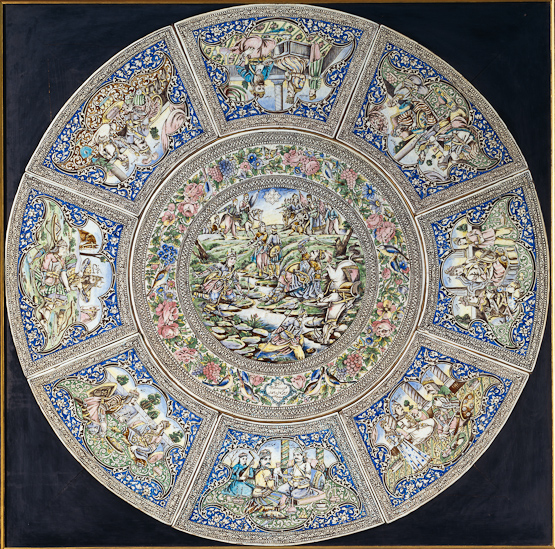
Qajar: Tehran, 1886–1887
Artist: ‘Ali Mohammad kashigar (potter) Esfahani
Patron: Colonel Robert Murdoch Smith
Nine fritware tiles with underglaze colours
London, Victoria and Albert Museum, Inv. 559-1888
Intended for display rather than practical use, this table top was made in 1886–1887 for Colonel Robert Murdoch Smith, an officer in the Royal Engineers who was seconded at the time to work on the development of the Persian telegraph, became its Director, and was later knighted as Major General Sir Robert Murdoch Smith. He collected Persian art for the South Kensington Museum and became Director of the Edinburgh Museum of Science and Art. Interested in the craftsmanship of the tileworker ‘Ali Mohammad Esfahani, he commissioned this table top as a showpiece of the potter’s remarkable skills and painterly use of perspective, shading and graded colours.
The central disc shows Rostam’s defeat of the Turanian Ashkabus (see No. 37). The ring of birds and flowers, typical of the Qajar period, contains a cartouche with the date and the names of partron and artist. The tiles forming the outer circle contain scenes from the Shahnameh, historical and literary figures.
They are listed clockwise, starting from the scene on the bottom right:
90a. Shah ‘Abbas I (1587–1629) is shown enthroned, with Hoseyn-e Kord (‘Hoseyn the Kurd’), a hero of popular contemporary storytelling, whose nisbeh (appellation) is Shabestari. The number ‘2’ in Western mode is inscribed on a column base.
90b. Shah ‘Abbas I (1587–1629) enthroned and sharing a cup with Khorram-e Chini, the follower of Malek Shah of Chin, a character in the romance of Hoseyn-e Kord (see No. 90a).
90c. The Shahnameh hero Gudarz, shown leaning against a bolster, and his son Giv, the father of Bizhan, were two of the most loyal paladins of Iran. They followed Key Khosrow when he resigned his throne and went into the mountains. Gudarz, by the order of Khosrow, left the mountains, but Giv remained and died in the snow (see No. 53).
90d. Labelled ‘Battle of Rostam with Sohrab’, this Shahnameh scene shows Rostam tearing his garments in despair at having killed his son Sohrab (see No. 82). The number 8 is written in Persian and Western mode below the mace.
90e. Hoseyn-e Kord (‘Hoseyn the Kurd’), who appears with Shah ‘Abbas on another tile (No. 90a), reclines attended by a young cupbearer named Yusof II, with whom Hoseyn amused himself after one of his exploits. Yusof is the epitome of the beautiful and virtuous servant. The primary Yusof, the biblical Joseph, appears in the Qur’an, but was better known in Iran from Jami’s narrative poem, Yusof o Zoleykha.
The number 3 in Persian and Western mode is incorporated into the carpet.
90f. Hushang, the second king in the Shahnameh, is depicted enthroned, with his son and successor, Tahmuras, before him.
90g. The Turanian Afrasiyab, principal enemy of Iran in the Shahnameh, is shown enthroned with one of his warriors, Ashkabus, before him. The latter’s name is spelled differently from the version in the central tile. The number 7 is inscribed in Persian and Western mode on the column.
90h. Qahraman, an Iranian hero, is depicted enthroned, with Qahtaran, another Shahnameh hero, before him. The number 4 in Persian and Western mode is incorporated into the carpet below the throne.




